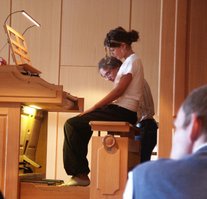I have been teaching children the organ by the Suzuki method for 22 years, with great success. It is so easy to make children interested in playing the organ, Just the fact that they get to play with their feet, and that they can choose between all the different sounds, make it fun. My opinion is that it is the most appealing instrument for children to begin with - a simple melody with a couple of base notes in the feet, registered with “tutti” – and the sound of the organ will lift the roof of the church! What other instrument has this opportunity!
Children learn easy coordination
It is good to begin to play the organ as a child, because it is so easy for children to learn coordination. To be able to play the organ, you need to develop ability to manage advanced coordination. Therefore it is perfect to begin with the Suzuki method, where you are allowed to concentrate on the hands and feet directly.

Sight reading
For all the people that worry about the sight reading, I can tell that I introduce reading the music very early, parallel with playing by heart, but from other material. I use ”Sight Reading”, a material that develop their ”Prima Vista Reading”. It is good that there is just two note lines when children shall learn to read music. It is important to choose material that has melodies in the left hand, not chords. Don´t use a book that is meant to be studied by heart.
It is so important to not leave the sight reading too much behind, because you must develop an ability to read three note lines in organ literature.
When the children reach book 3 in the Suzuki Organ School, I have already trained their sight reading through other material for a long time. But in book 3 I start to use their ability to read in the Suzuki literature. In the first piece in book 3 I start to give them a few bars from the right hand or the left hand or the pedal as note reading assignment, and the rest of the piece I teach by heart as usual. In this way I introduce the sight reading in the Suzuki material, and after a while, the children have caught up with the sight reading, so it is in the same level as their playing ability.
It is perfect to learn the base clef by reading the pedal part, because there is mostly one note at the time to read, comparing with the left hands base notes that often have chords.
Pedal technique
In the literature all the manual pieces also have pedal. But from the beginning there are just two or three pedal notes in those pieces, to let the children concentrate on the hands. But between every manual piece, there is a solo pedal piece to develop the pedal technique.
When the students have gained more knowledge in coordination, the pedal parts in the manual pieces get more and more advanced. In book 4, there are just a few pedal exercises beside the ordinary pieces.

No shoes for children?
In the beginning the students play in their socks, to be able to get the right feeling for touching the pedals. The move comes from the ankle, and they touch the pedal between the big toe and the second toe. In this way, the children become very aware about how they press and release the pedal key in a soft way. In the end of book 1, we introduce playing with the heel.
When the students get older and the pedal parts are more difficult, they can start to use shoes.
”The most important thing when you meet a young child is to implement the right moves. The speed and the technique will come later.”
Articulation
In the Suzuki organ method we teach the children both non legato and legato from the beginning. To avoid tensions we start with non legato. I am very concerned about the relaxed hands, and I have found a way to teach every child to play without tensions in their hands, arms and body. When we have gained the relaxed hand by the twinkle variations and the first non legato pieces, we introduce legato. And further on we play differentiated non legato pieces and legato pieces parallel, to make the children very skilful at different articulations.
In the first 4 books in the Suzuki organ school there are suggestions about the differentiated non legato articulation, to implement the ability to play differentiated. In book 5 the students have gained the sense for articulation and do it by themselves.
The Suzuki literature has a fast progression
There is a difference between the Suzuki literature and other instrumental schools.
The Suzuki schools have a faster progression, where every piece brings a new technical difficulty. In most of the other schools, the technical level is the same during several pieces, and as a teacher you don’t have to be as careful how you teach, because you have many pieces where you can practise the same technical skills.
This is the reason why you need to be an educated Suzuki teacher, to be able to use the Suzuki literature. The progression is fast, and you need to know how to teach during these circumstances. It is also important to not leave the piece before the child perform it well. Otherwise the student doesn’t have the skills to manage the following pieces.
Examples of contents of an organ lesson with a small child
To explain how you do to teach step by step in literature with fast progression, I will give you some examples of content in an organ lesson with a small child.
When you teach you make small exercises before every moment that needs special attention. You work very thoroughly with ergonomic and articulation. The teacher makes the parent pay attention continuously during the lesson, what to think about, and makes sure that the parent understands.
To believe in every child’s ability to learn
The Philosophy of the Suzuki method is to believe in every child’s ability to learn. We know that “everyone can”, it just takes different long time to learn. It is extremely important to develop the child’s self-esteem and joy for playing, by always point out every small detail that the child does well, and make them feel good about that. And from this state of feeling, you add some things that you work on to improve until the child manage it.
In this way you create a desire by the child to improve, and a feeling that they will manage.
To make all students play beautiful
A good teacher never gives up, and continues to work with the child until every detail is well done. A combination of persistence, enthusiasm and knowledge is the recipe to succeed as a teacher. Except that the teacher must pay attention to the child and see when the student loses concentration. Then it’s time to take a break and do something else. It’s necessary to do various things in the lesson, and make fun things in-between the more demanding exercises.
Important qualities and knowledge by a good Suzuki teacher
Believe that everybody can
It is a privilege to follow in the footsteps of Shinichi Suzuki. When you work with the Suzuki method, you become a part of children´s life and development, and that gives your life a true meaning. The engagement in educating, and the genius way to teach, is inspiring and enriching in so many ways.
I am enormously grateful that I have had the opportunity to learn this method and meat all the inspiring teachers all over the world. I have been overwhelmed of their engagement in teaching children and of the respect between teachers, between teacher and parents, and between teachers and children. This is something that permeates all through the Suzuki movement, and I don´t find a similar phenomenon elsewhere in society.
I have been particularly fascinated of the teachers that work in material poor environments, because their engagement and the importance of their work is so incredible valuable, rich and good for the humanity.
I have understood that all the teachers who have studied for Shinichi Suzuki learned humbleness, respect for others and a positive belief in all children. For me these qualities are the most important of a human being.
I really want to encourage all people who are interested in pedagogic, to learn about the Suzuki method. As a first step you can read the book about Shinichi Suzuki "Nurtured by love".
Gunilla Rönnberg © 2020 All rights reserved